Investigation of the Jet Characteristics and Pulse Mechanism of Self-Excited Oscillating Pulsed Jet Nozzle
Abstract
:1. Introduction
2. Numerical Models and Evaluation Indexes of Jet Performance
2.1. Numerical Analysis Model
2.1.1. Governing Equations
- LES control equations
- (1)
- Navier–Stokes equations
- (2)
- Filter functions
- (3)
- LES control equations
- (4)
- The sub-grid scale model
- 2.
- Homogeneous Equilibrium Model
- (1)
- Continuity equation:
- (2)
- Momentum equation:
- (3)
- Volume fraction equation:
- (4)
- Rayleigh established the Rayleigh–Plesset Equation (13) on the condition of incompressible flow. The equation can be used to calculate the process of bubble movement, growth, and collapse.
2.1.2. Calculation Model
- Nozzle geometry and calculation setup
- 2.
- Boundary conditions and fluid properties
- 3.
- Calculation Settings
2.2. Computational Model Validation
2.2.1. Experimental Verification
2.2.2. Mechanism Validation
2.3. Jet Performance Evaluation Indexes
- Peak velocity
- 2.
- Oscillation frequency
- 3.
- Cavitation number
3. Results and Discussion
3.1. Influences of Structural Parameters on Jet Performance
3.1.1. Influence of Inlet Diameter on Jet Performance
- Influence of inlet diameter on peak velocity and oscillation frequency.
- 2.
- Influence of inlet diameter on cavitation number
3.1.2. Influence of Cavity Diameter on Jet Performance
- Influence of cavity diameter on peak velocity and oscillation frequency
- 2.
- Influence of cavity diameter on cavitation number
3.1.3. Influence of Cavity Length on Jet Performance
- Influence of cavity length on peak velocity and oscillation frequency
- 2.
- Influence of cavity length on cavitation number
3.1.4. Influence of the Angle of Reflection of the Wall on Jet Performance
- Influence of wall reflection angle on peak velocity and oscillation frequency
- 2.
- Influence of wall reflection angle on cavitation number
3.2. Synthesis of Results and the Influence of Operating Parameters on Jet Performance
- Synthesis of results
- 2.
- Influence of inlet pressure on jet performance
4. Conclusions
- (1)
- A self-excited oscillating pulse jet formation mechanism was described. The results show that the number of serial eddies in the disturbance layer is proportional to the oscillation frequency. When the serial eddies remain the same, there is a larger steam pocket and lower oscillation frequency.
- (2)
- The influences of the key structural parameters of self-excited oscillating nozzles on peak velocity, oscillation frequency, and critical cavitation number were revealed. With increases in inlet diameter, cavity diameter, cavity length, and wall reflection angle, the oscillation frequency decreases. Peak velocity fluctuates with changes in the cavity diameter, while the critical cavitation number increases with cavity diameter. As the inlet pressure increases, the peak velocity gradually increases and the peak velocity enhancement decreases.
- (3)
- The working performance of a self-excited oscillating nozzle is influenced by its structural parameters and working pressure. The nozzle has a better cavitation capability, oscillation effect and greater peak velocity when d1/d2 = 0.818, D/d2 is approximately 9, L/d2 = 3–3.5, and the angle α= 60–70°. Then, in this situation, the self-excited oscillating nozzle has better cleaning ability at a constant working pressure. However, the increase in working pressure is beneficial to increasing the peak velocity and enhancing the cleaning ability of the self-excited oscillating nozzle.
Author Contributions
Funding
Institutional Review Board Statement
Informed Consent Statement
Data Availability Statement
Conflicts of Interest
Nomenclature
| ν | Viscosity coefficient, dimensionless, ν = 1/Re |
| Re | Reynolds number, dimensionless |
| F | Body force, N |
| P | Fluid pressure, Pa |
| u | Velocity, m/s |
| Δi | Length of grid, m |
| τij | Grid dimension stress, N |
| υτ | Eddy viscosity coefficient, dimensionless |
| Cs | Smagorinsky constant, Cs = 0.1 |
| ij | Tensor of deformation rate |
| Δ | Filtering width, m, Δ = (Δx2 + Δy2)1/2 |
| ρ | Mixture density, kg/m3 |
| μ | Mixture dynamic viscosity, Pa·s |
| Velocity, m/s | |
| t | Time, s |
| n | Number of bubbles |
| r | Radius of the bubble, m |
| σ | Surface tension of the fluid, N |
| pvap | Pressure within the bubble, Pa |
| D | Cavity diameter, m |
| L | Cavity length, m |
| α | Reflection angle of wall, degree |
| d0 | Pipe diameter, m |
| a | Wave velocity, m/s |
| K | Cavitation number, dimensionless |
| pi | Absolute pressure of fluid, Pa |
| ps | Saturation pressure of fluid, Pa |
| Δx, Δy | The width of grid along with the X axis and Y axis direction, m |
| ρl, ρν | Liquid density, Vapour density, kg/m3 |
| μL, μν | Liquid dynamic viscosity, Vapour dynamic viscosity, Pa·s |
| βl, βν | Volume fraction of liquid, Volume fraction of vapour, % |
| d1, d2 | Inlet diameter, Outlet diameter, m |
References
- Domínguez, A.; Menéndez, J.A.; Inguanzo, M.; Pis, J.J. Investigations into the characteristics of oils produced from microwave pyrolysis of sewage sludge. Fuel Process. Technol. 2005, 86, 1007–1020. [Google Scholar] [CrossRef]
- Han, W.L. Storage Tank Corrosion and Its Protection Measures. Pet. Eng. Constr. 2010, 36, 41–47. [Google Scholar]
- Xu, R.L. Present Situation and Research of Treatment of Sludge from Oil-tanks. Petrochem. Saf. Technol. 2003, 19, 36–39. [Google Scholar]
- Shaheen, S.E.; Zhou, A.L. Chemical processing and machinery operation of tank cleaning. Foreign Oilfield Eng. 2000, 7, 48–50. [Google Scholar]
- Wartel, M. Method for Cleaning an Oil Storage Tank and Device for Implementing Same. European Patent EP1091812, 22 August 2007. [Google Scholar]
- Dixon, R. Storage Tank Cleaning Method and Apparatus. U.S. Patent EP2303475, 23 December 2009. [Google Scholar]
- Morel, T. Experimental study of a jet-driven Helmholtz oscillator. Am. Soc. Mech. Eng. 1978, 101, 383–390. [Google Scholar] [CrossRef]
- Liao, Z.F.; Tang, C.L. Theory of the self-excited oscillation pulsed jet nozzle. J. Chongqing Univ. 2002, 25, 24–27. [Google Scholar]
- Liao, Z.F.; Li, J.; Chen, D.; Deng, X.; Tang, C.; Zhang, F. Theory and experimental study of the self-excited oscillation pulsed jet nozzle. Chin. J. Mech. Eng. 2003, 16, 379–383. [Google Scholar] [CrossRef]
- Fang, Z.L.; Zeng, F.D.; Xiong, T.; Wei, W.; Jiang, P.; Wu, Q.; Wang, Y.; Fei, Y. Large eddy simulation of self-excited oscillation inside Helmholtz oscillator. Int. J. Multiph. Flow 2020, 126, 103253. [Google Scholar] [CrossRef]
- Liu, X.Y.; Xu, H.Z.; Zhao, L.; Yu, X.; Chen, H.; Zhang, S.; Ji, J. Investigation of the impact characteristics and pulse mechanism of a self-excited aspiration pulsed jet device. Exp. Therm. Fluid Sci. 2021, 124, 110371. [Google Scholar] [CrossRef]
- Wang, H.M.; Jiao, L. Numeireal simulation of self- excited oscillation Pulsed jet and analysis of Parameters’ influence. J. Zhejiang Univ. (Eng. Sci.) 2005, 39, 1450–1454. [Google Scholar]
- Hu, D.; Li, X.H.; Tang, C.-L.; Kang, Y. Analytical and experimental investigations of the pulsed air–water jet. J. Fluids Struct. 2015, 54, 88–102. [Google Scholar] [CrossRef]
- Tang, C.L.; Hu, D.; Zhang, F.H. Study on the frequency characteristic of self-excited oscillation pulsed water jet. Adv. Mater. Res. 2011, 317–319, 1456–1461. [Google Scholar] [CrossRef]
- Peng, G.Y.; Shimizu, S. Progress in numerical simulation of cavitation water jets. J. Hydrodyn. 2013, 25, 502–509. [Google Scholar] [CrossRef]
- Tamaki, N.; Shimizu, M.; Hiroyasu, H. Enhancement of the atomization of a liquid jet by cavitation in a nozzle hole. At. Sprays 2001, 11, 125–137. [Google Scholar]
- Payri, F.; Payri, R.; Salvador, F.J.; Martínez-López, J. A contribution to the understanding of cavitation effects in Diesel injector nozzles through a combined experimental and computational investigation. Comput. Fluids 2012, 58, 88–101. [Google Scholar] [CrossRef] [Green Version]
- Xiang, L.H.; Wei, X.S.; Chen, S.Y. Experimental study on the frequency characteristics of self-excited pulsed cavitation jet. Eur. J. Mech. B/Fluids 2020, 83, 66–72. [Google Scholar] [CrossRef]
- Huang, M.; Kang, Y.; Wang, X.C.; Hu, Y.; Cai, C.; Liu, Y.; Chen, H. Experimental investigation on the rock erosion characteristics of a self-excited oscillation pulsed supercritical CO2 jet. Appl. Therm. Eng. 2018, 139, 445–455. [Google Scholar] [CrossRef]
- Li, H.S.; Liu, S.Y.; Jia, J.G.; Wang, F.; Guo, C. Numerical simulation of rock-breaking under the impact load of self-excited oscillating pulsed waterjet. Tunn. Undergr. Space Technol. 2020, 96, 103179. [Google Scholar] [CrossRef]
- Egerer, C.P.; Hickel, S.; Schmidt, S.J.; Adams, N. Large-eddy simulation of turbulent cavitating flow in a micro channel. Phys. Fluids 2014, 26, 1–40. [Google Scholar] [CrossRef]
- Ji, B.; Luo, X.W.; Arndt, R.E.; Peng, X.; Wu, Y. Large Eddy Simulation and theoretical investigations of the transient cavitating vortical flow structure around a NACA66 hydrofoil. Int. J. Multiph. Flow 2015, 68, 121–134. [Google Scholar] [CrossRef] [Green Version]
- Ji, B.; Luo, X.W. Three-dimensional large eddy simulation and vorticity analysis of unsteady cavitating flow around a twisted hydrofoil. J. Hydrodyn. 2013, 25, 510–519. [Google Scholar] [CrossRef]
- Molina, S.; Salvador, F.J.; Carreres, M.; Jaramillo, D. A computational investigation on the influence of the use of elliptical orifices on the inner nozzle flow and cavitation development in diesel injector nozzles. Energy Convers. Manag. 2014, 79, 114–127. [Google Scholar] [CrossRef]
- Vinkovic, I.; Aguirre, C.; Simoë, S.; Gorokhovski, M. Large eddy simulation of droplet dispersion for inhomogeneous turbulent wall flow. Int. J. Multiph. Flow 2006, 32, 344–364. [Google Scholar] [CrossRef]
- Yu, Y.S.; Li, G.X. Multiphase Large Eddy Simulation of Diesel Fuel Spray Atomization. Chin. Intern. Com-Bustion Engine Eng. 2009, 30, 39–44. [Google Scholar]
- Huang, B.; Zhao, Y.; Wang, G.Y. Large Eddy Simulation of turbulent vortex-cavitation interactions in transient sheet/cloud cavitating flows. Comput. Fluids 2014, 92, 113–124. [Google Scholar] [CrossRef]
- Li, G.S.; Shen, Z.H. Theory and Application of Self-Resonating Cavitating Water Jet; Chain University of Petroleum Press: Dongying, China, 2008. [Google Scholar]
- Lai, S.Q.; Liao, Z.F. The Theory and Experimental Study of the Self-Excited Oscillation Pulsed Jet Nozzle (Pipeline Pulsed Flow Generator). Nat. Resour. 2013, 4, 395–403. [Google Scholar] [CrossRef] [Green Version]
- Zhang, Z.S.; Cui, G.X.; Xu, C.X. Theory and Application of Numerical Simulation of Large Eddy Simulation Turbulence; Qinghua University Press: Beijing, China, 2008. [Google Scholar]
- Du, Y.K.; Wang, R.H.; Ni, H.J. Large eddy simulation of self-oscillation pulsed water jet drawing in annulus fluid. J. Hydrodyn. (Ser. A) 2009, 24, 455–462. [Google Scholar]
- Li, H.S. Rock Breaking Performance of Self-Excited Oscillating Pulsed Waterjet. Ph.D. Thesis, China University of Mining and Technology, Beijing, China, 2020. [Google Scholar]
- Wang, P.; Ni, H.J.; Wang, R.H. Modulating downhole cuttings via a pulsed jet for efficient drilling-tool development and field testing. J. Nat. Gas Sci. Eng. 2015, 27, 1287–1295. [Google Scholar] [CrossRef]
- Keller, A.P. Cavitation Scale Effects—Empirically Found Relations and the Correlation of Cavitation Number and Hydrodynamic Coefficients. In Proceedings of the CAV 2001: Fourth International Symposium on Cavitation, California Institute of Technology, Pasadena, CA, USA, 20–23 June 2001. [Google Scholar]
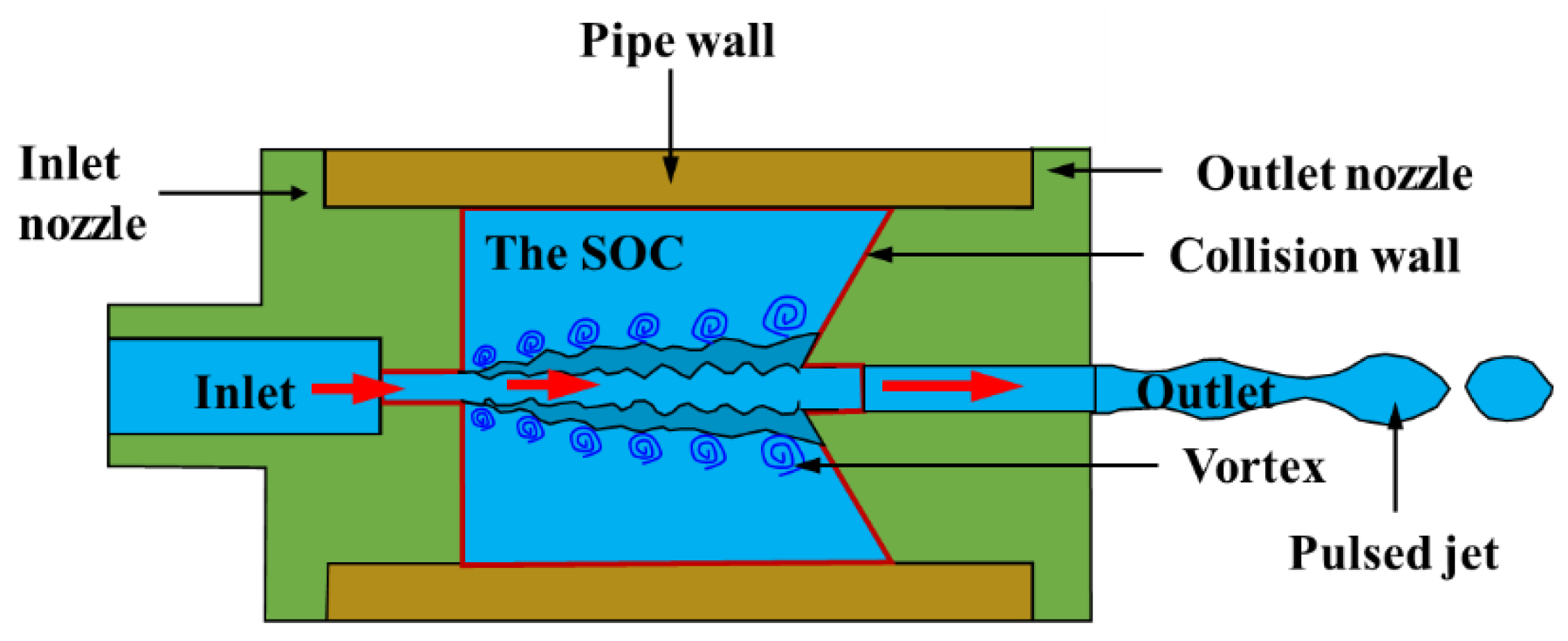



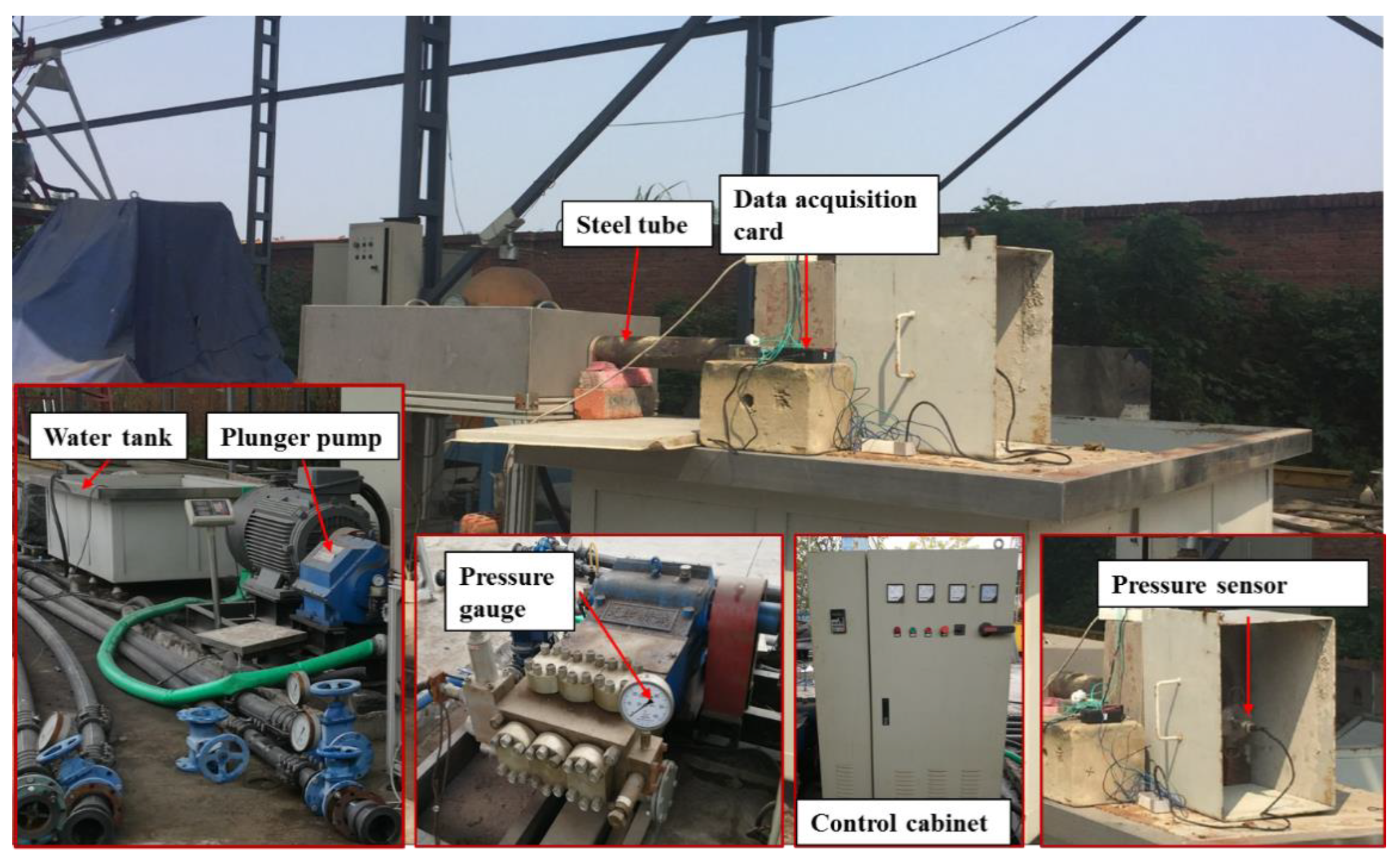
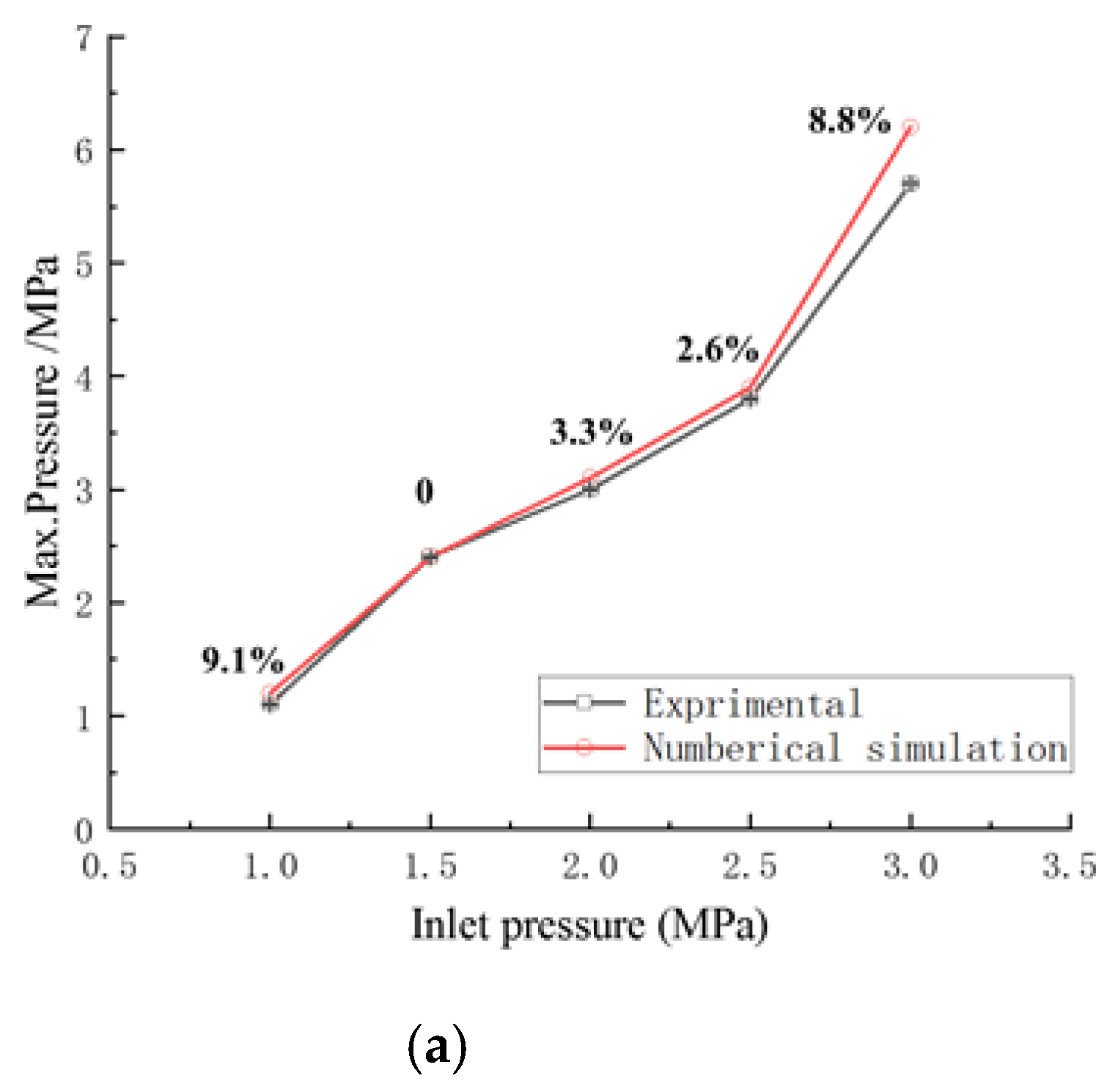
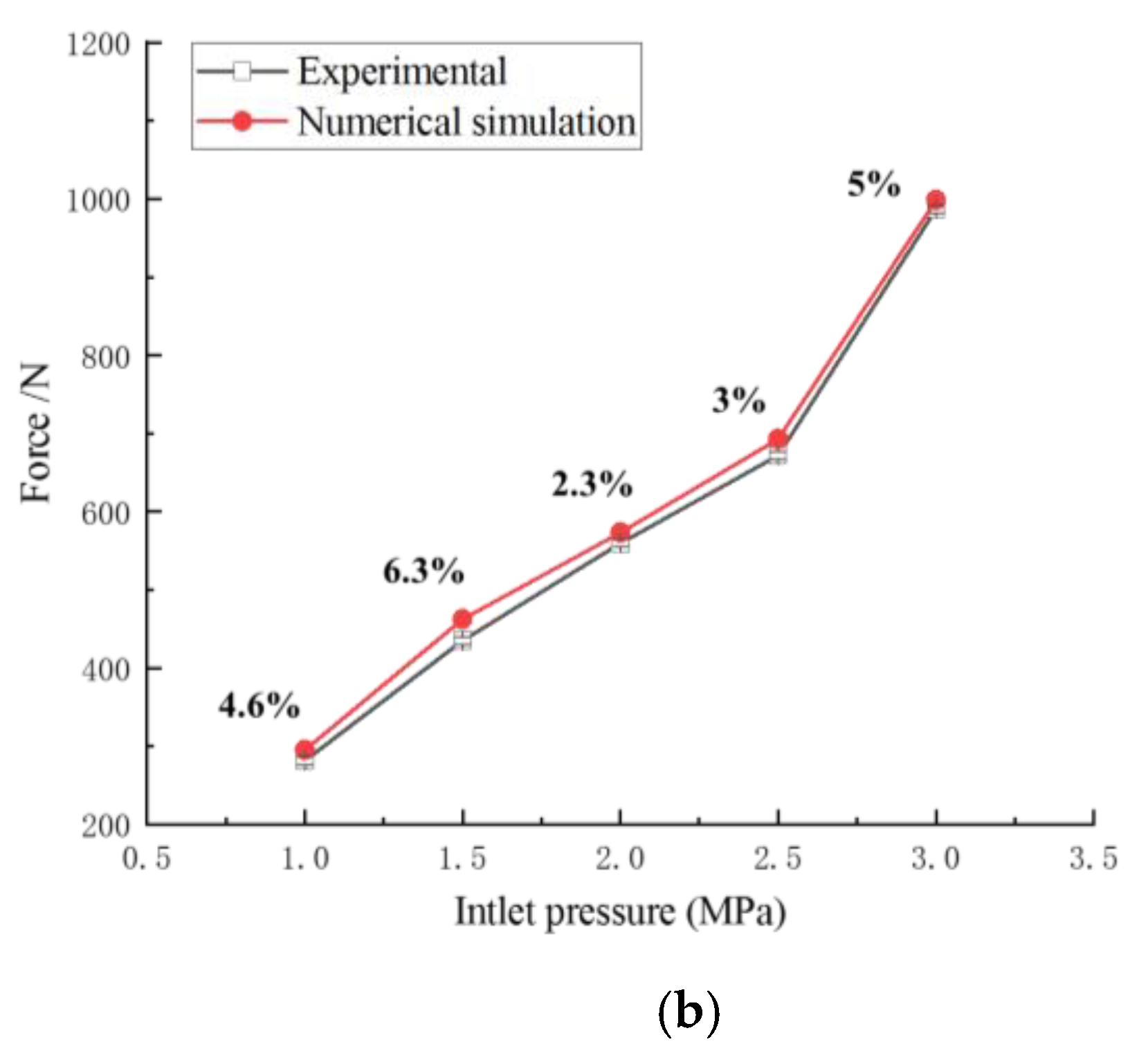

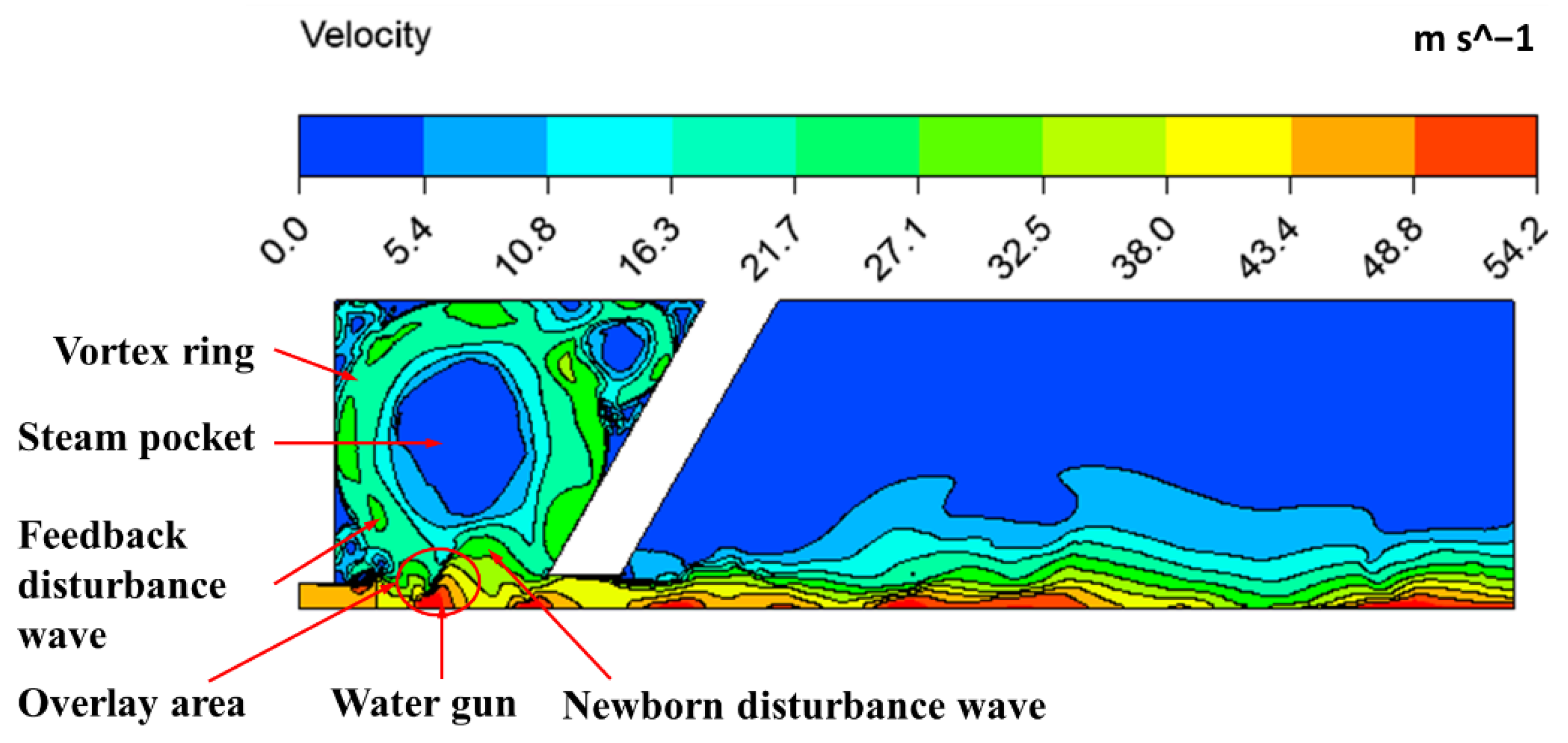
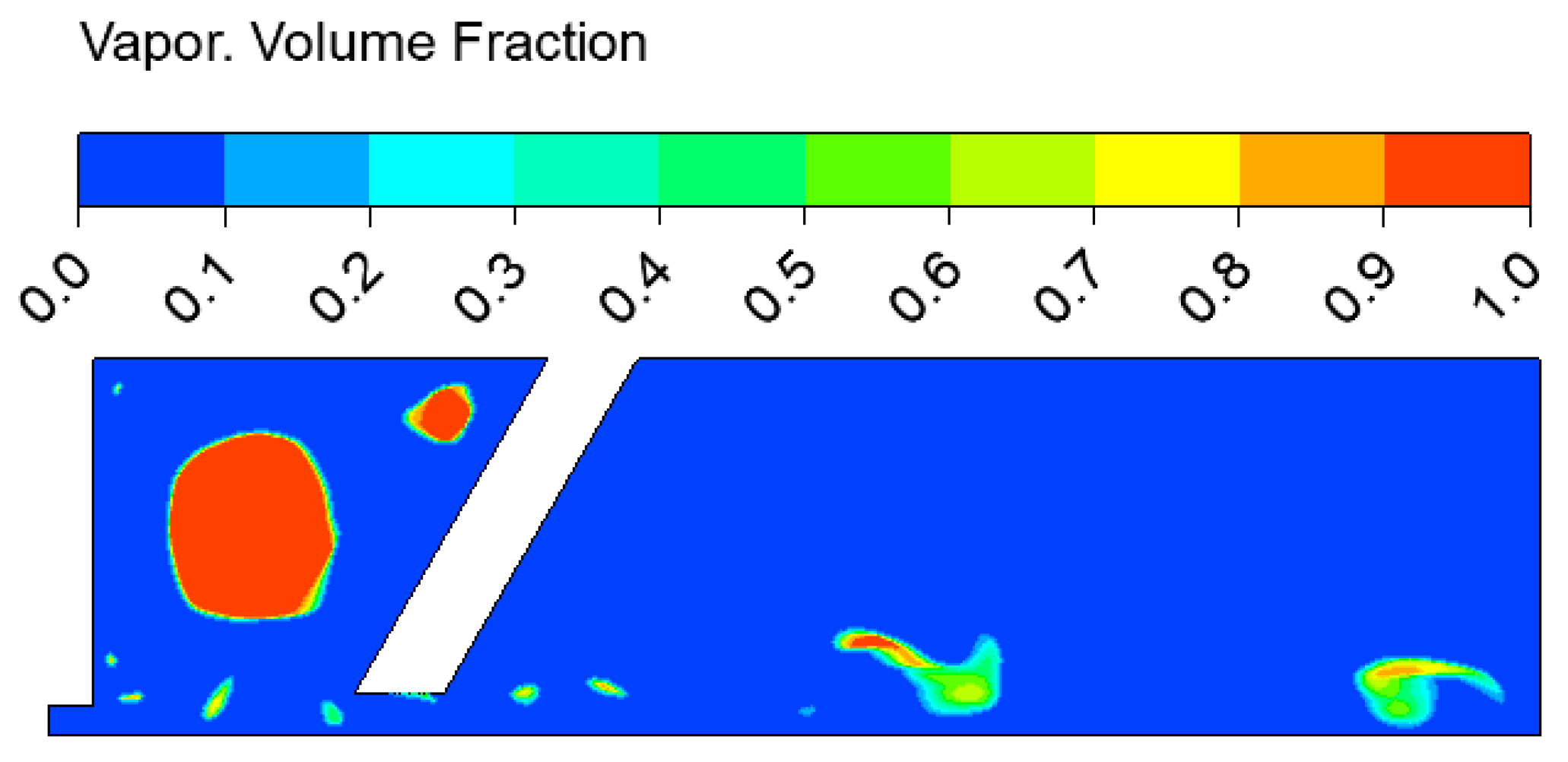
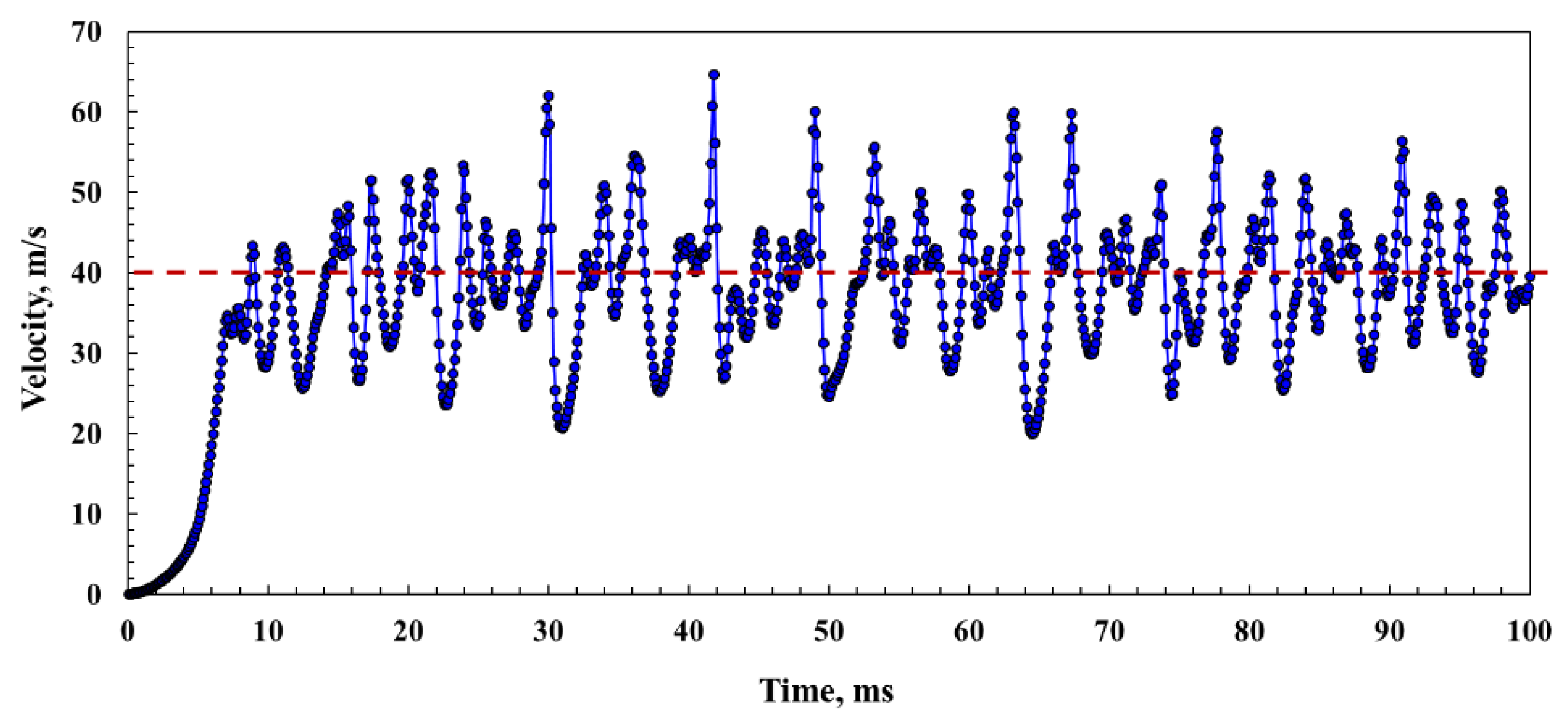
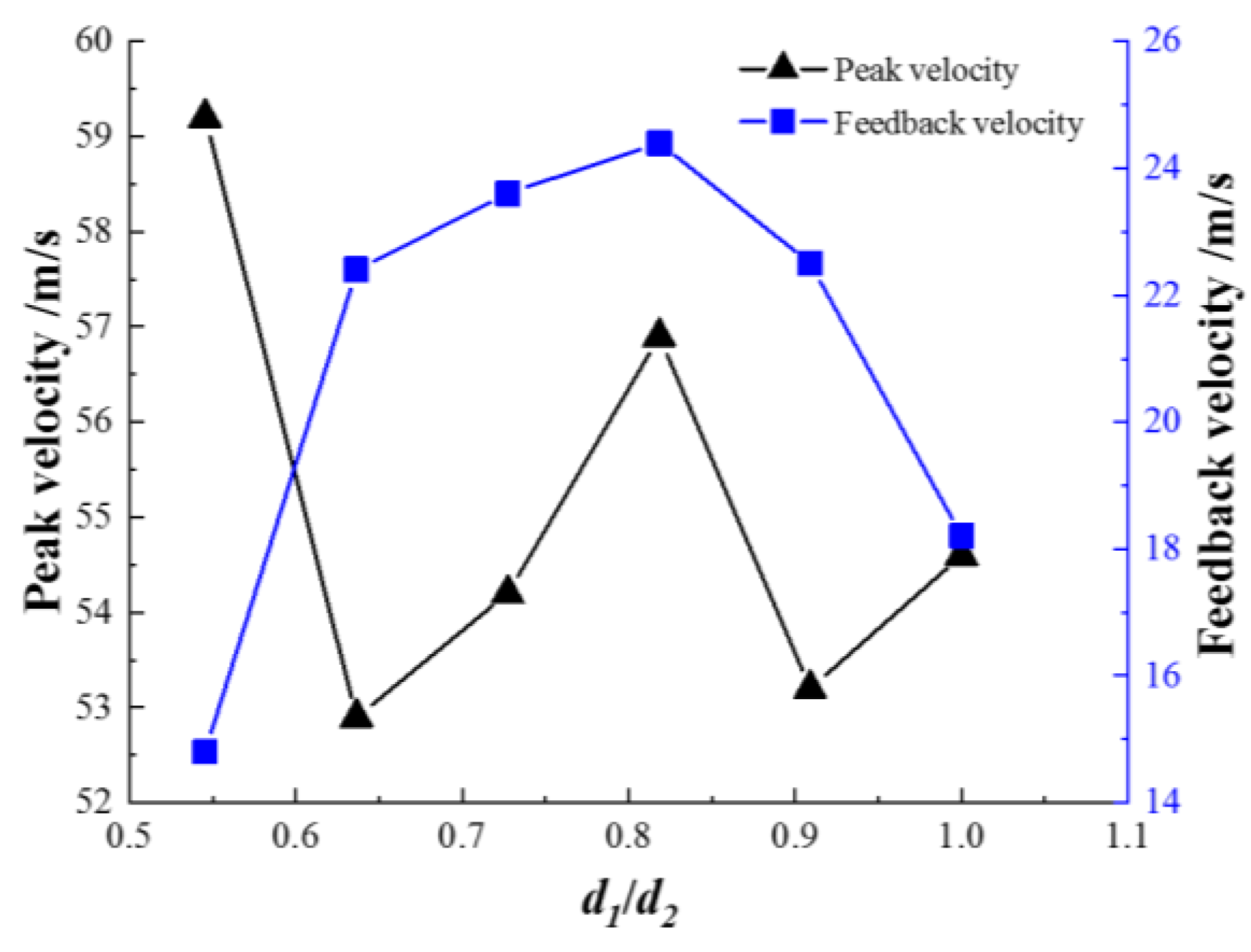
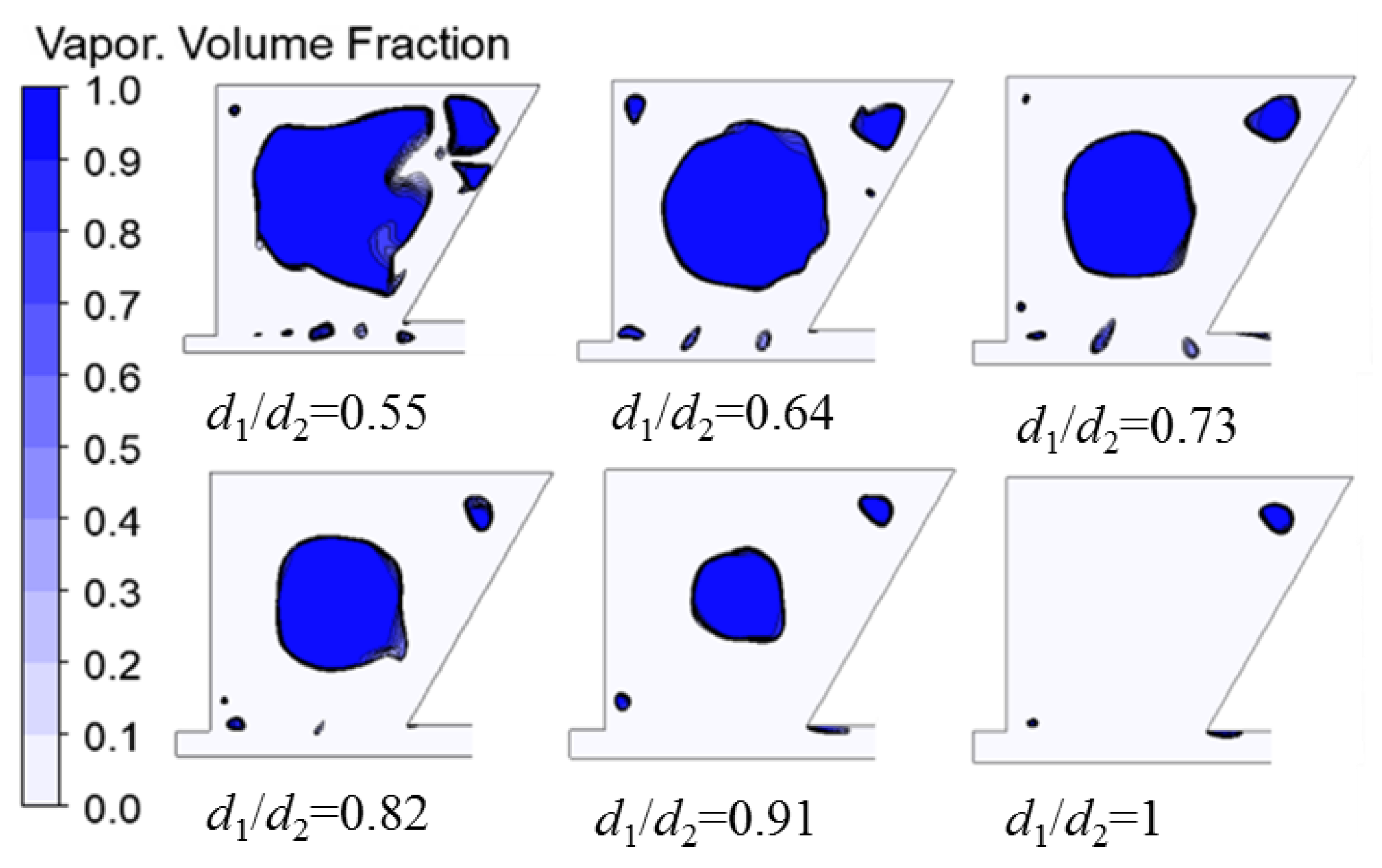
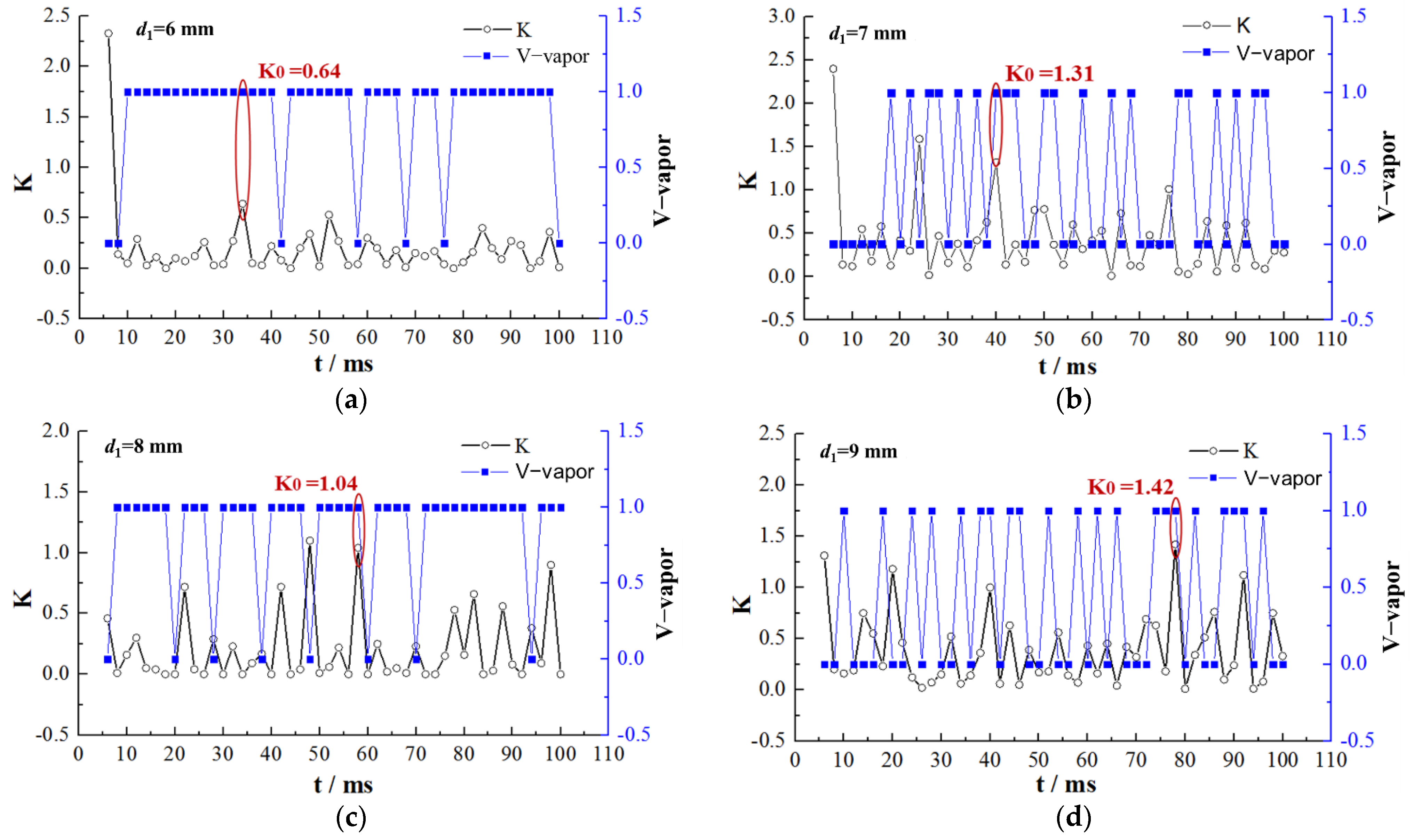

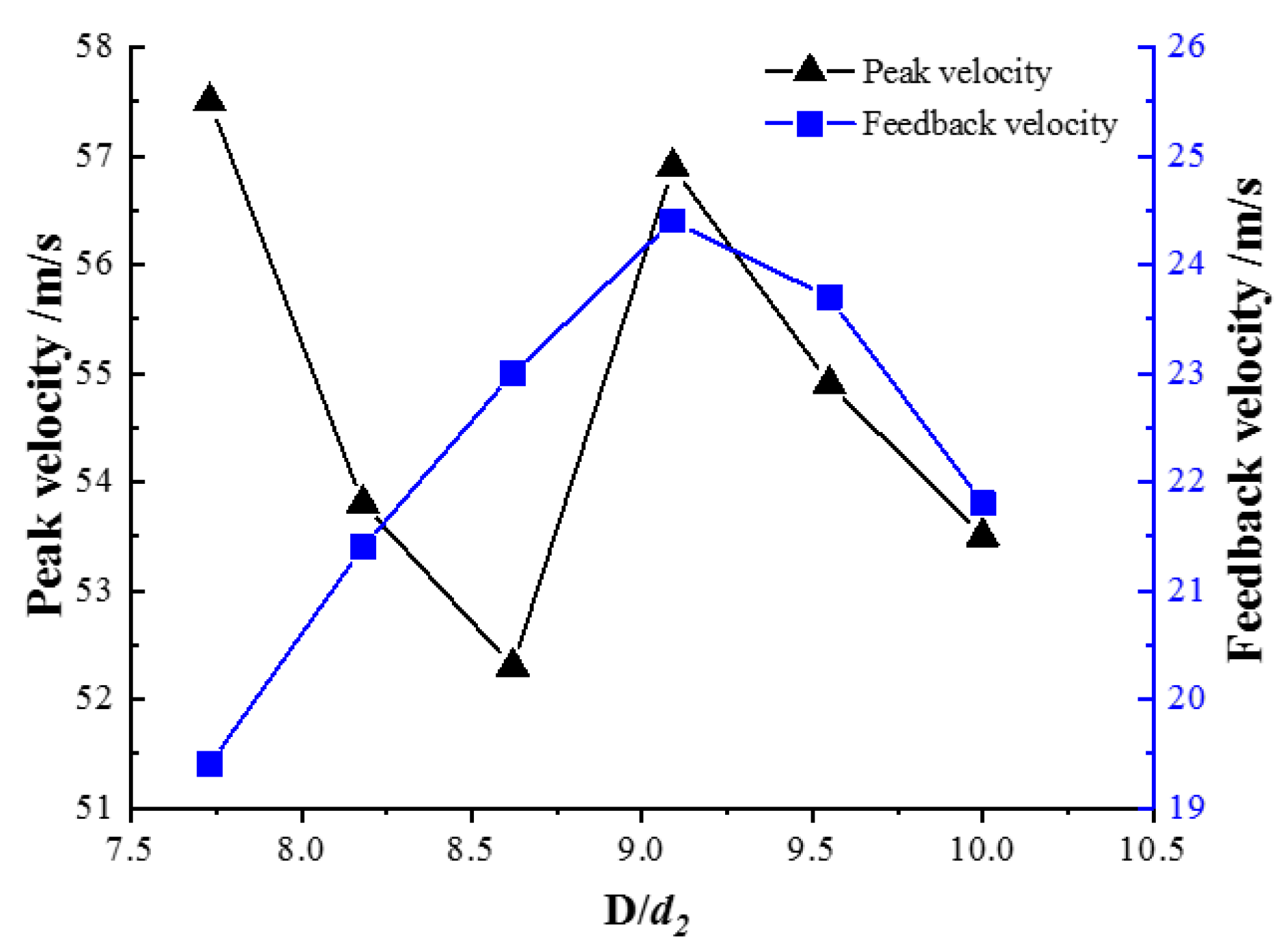

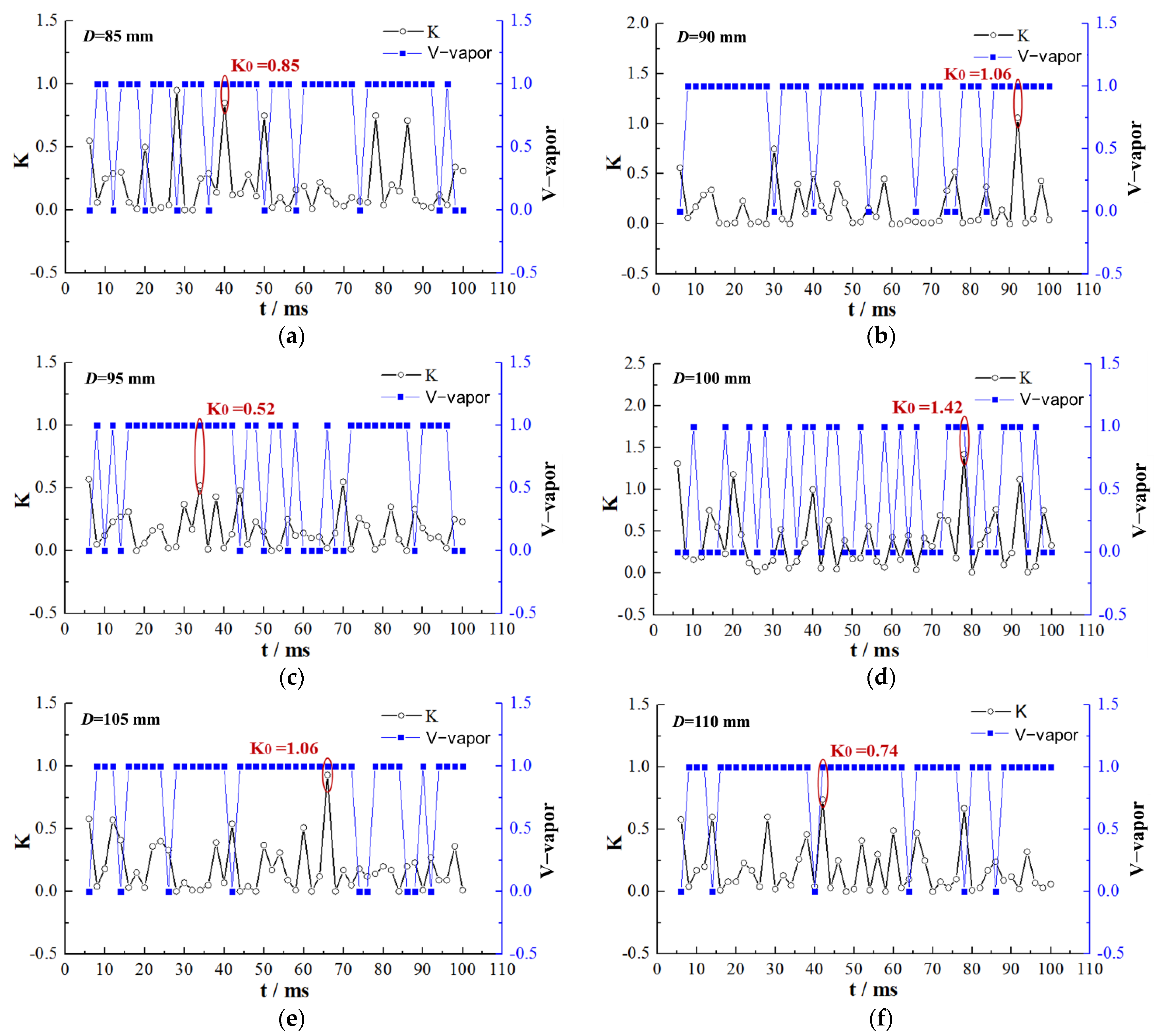
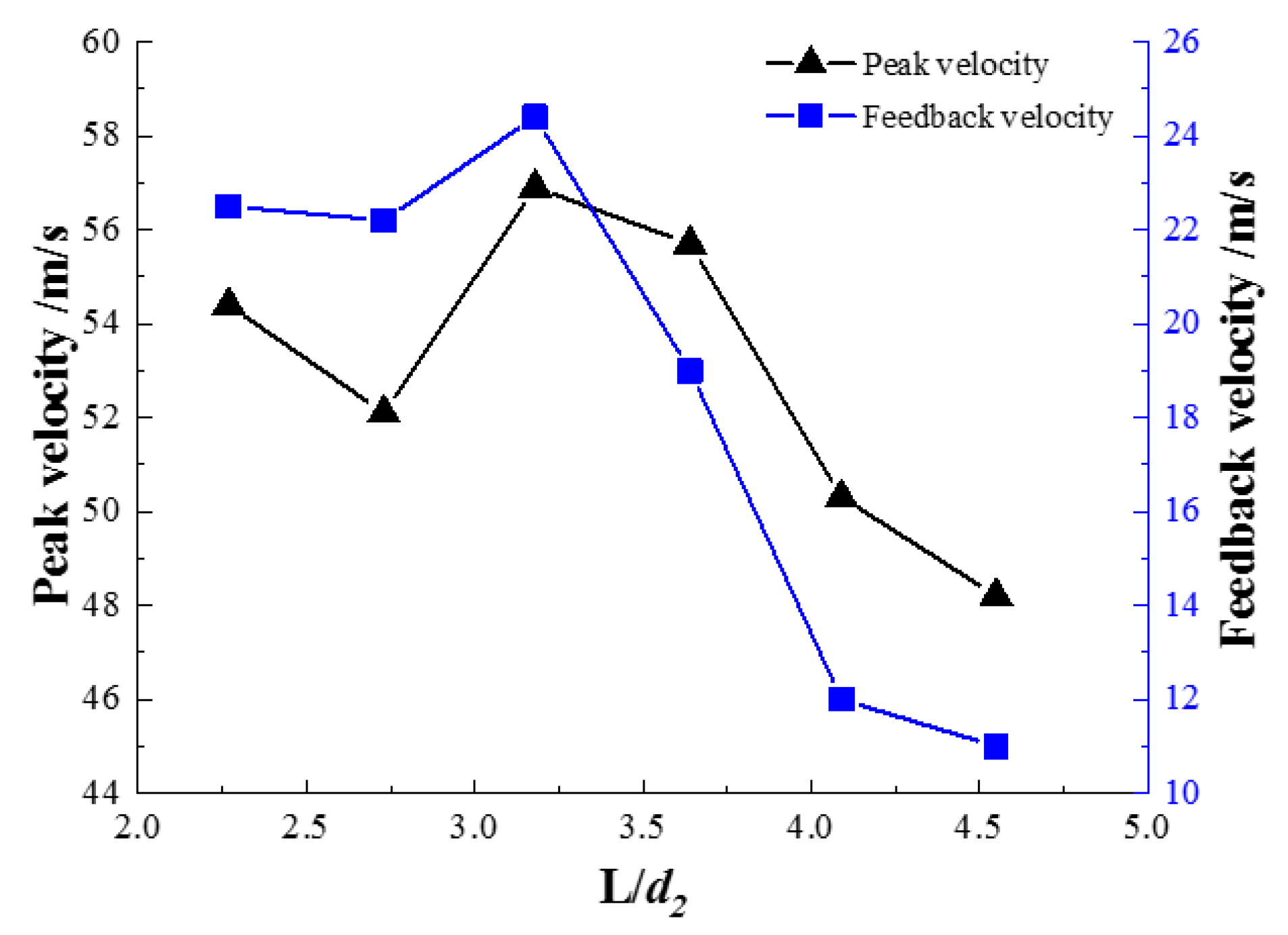
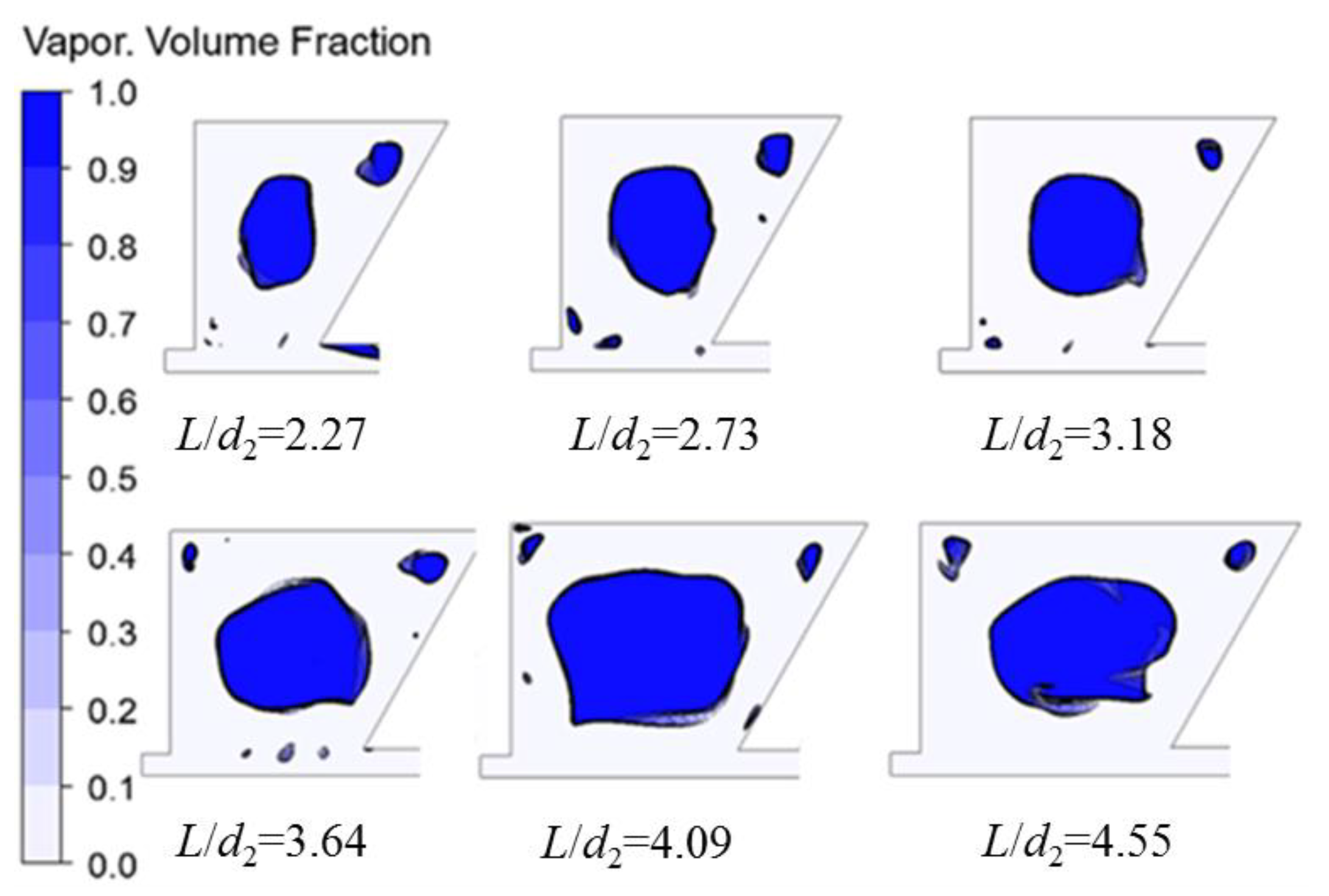
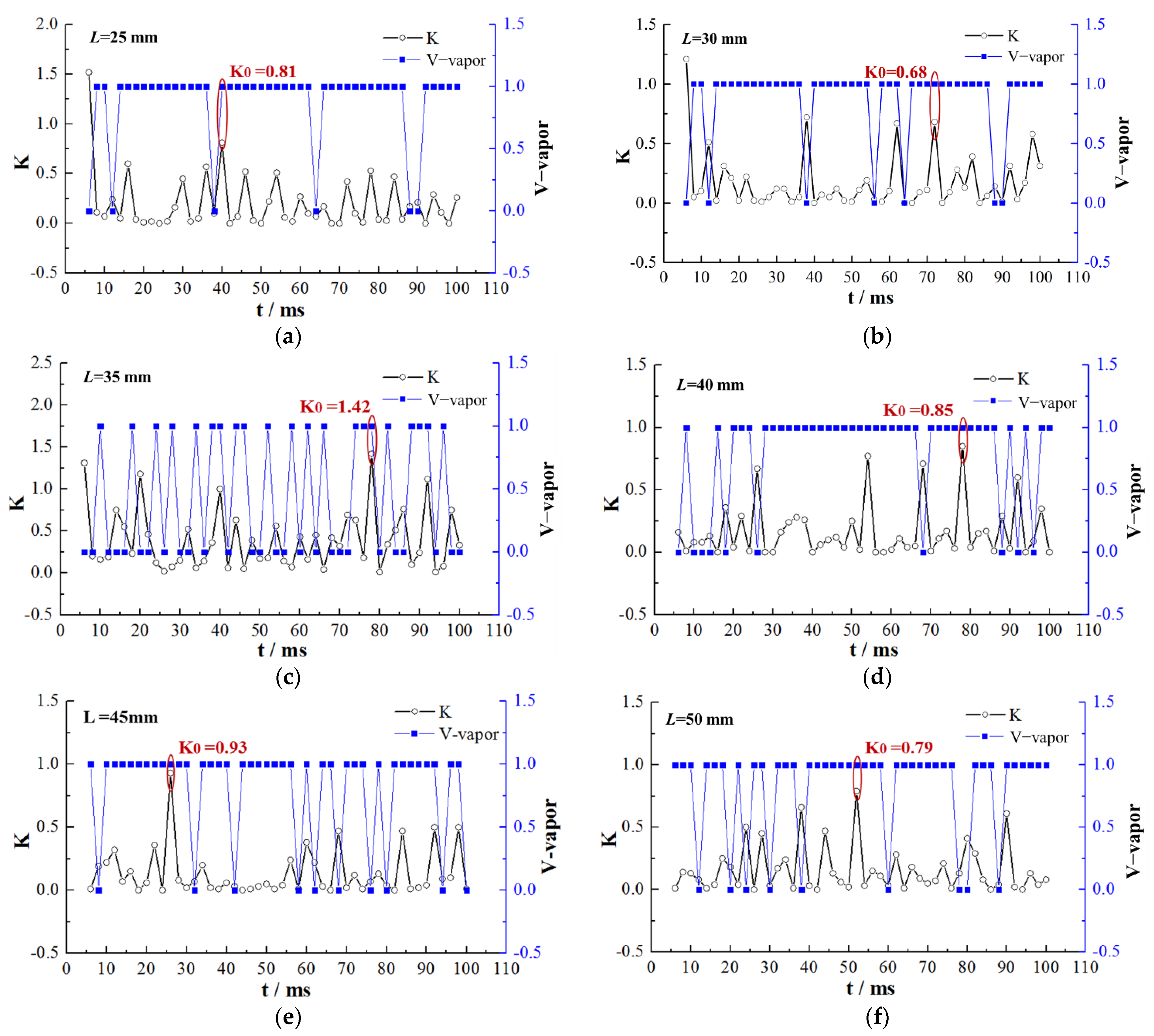

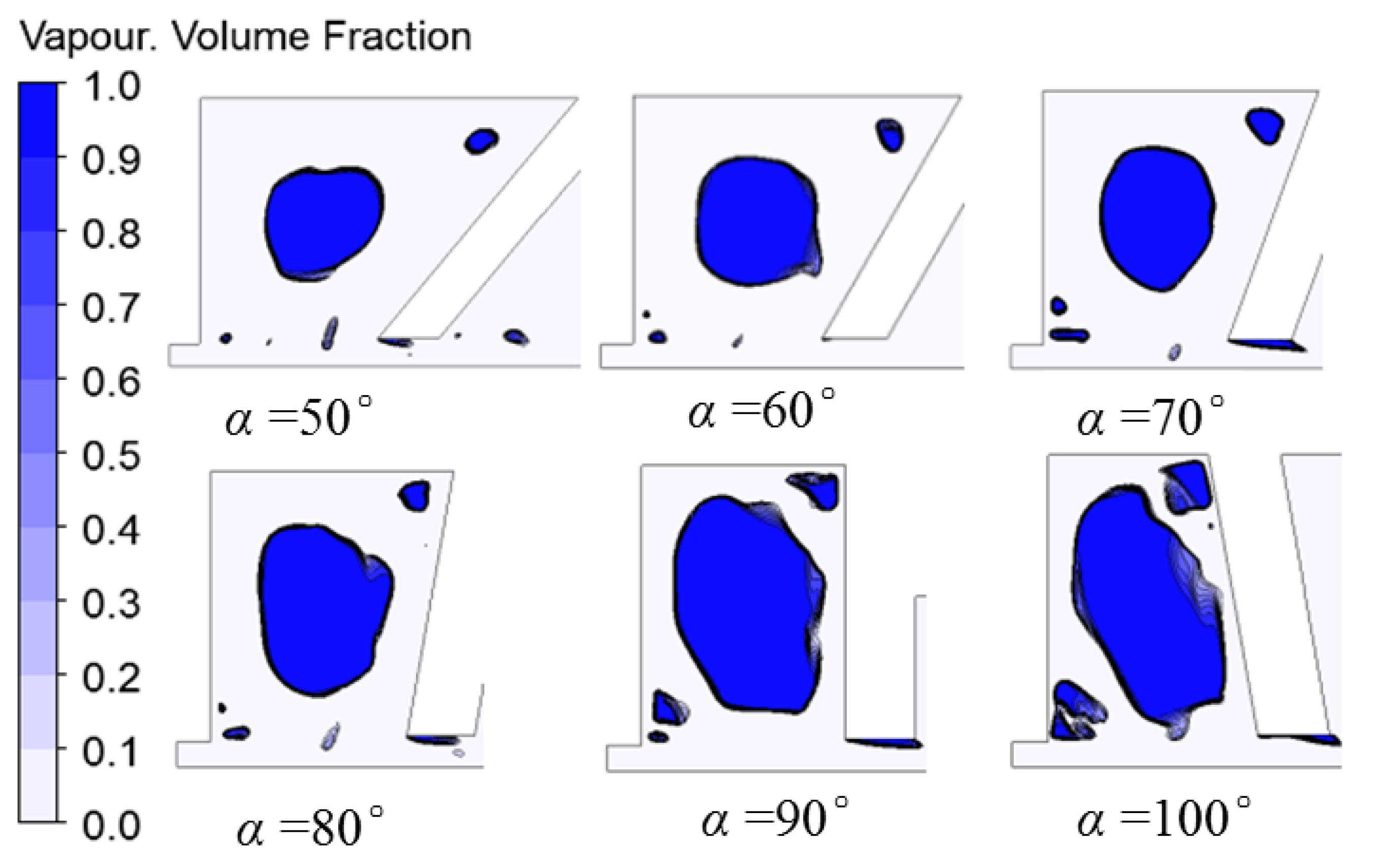
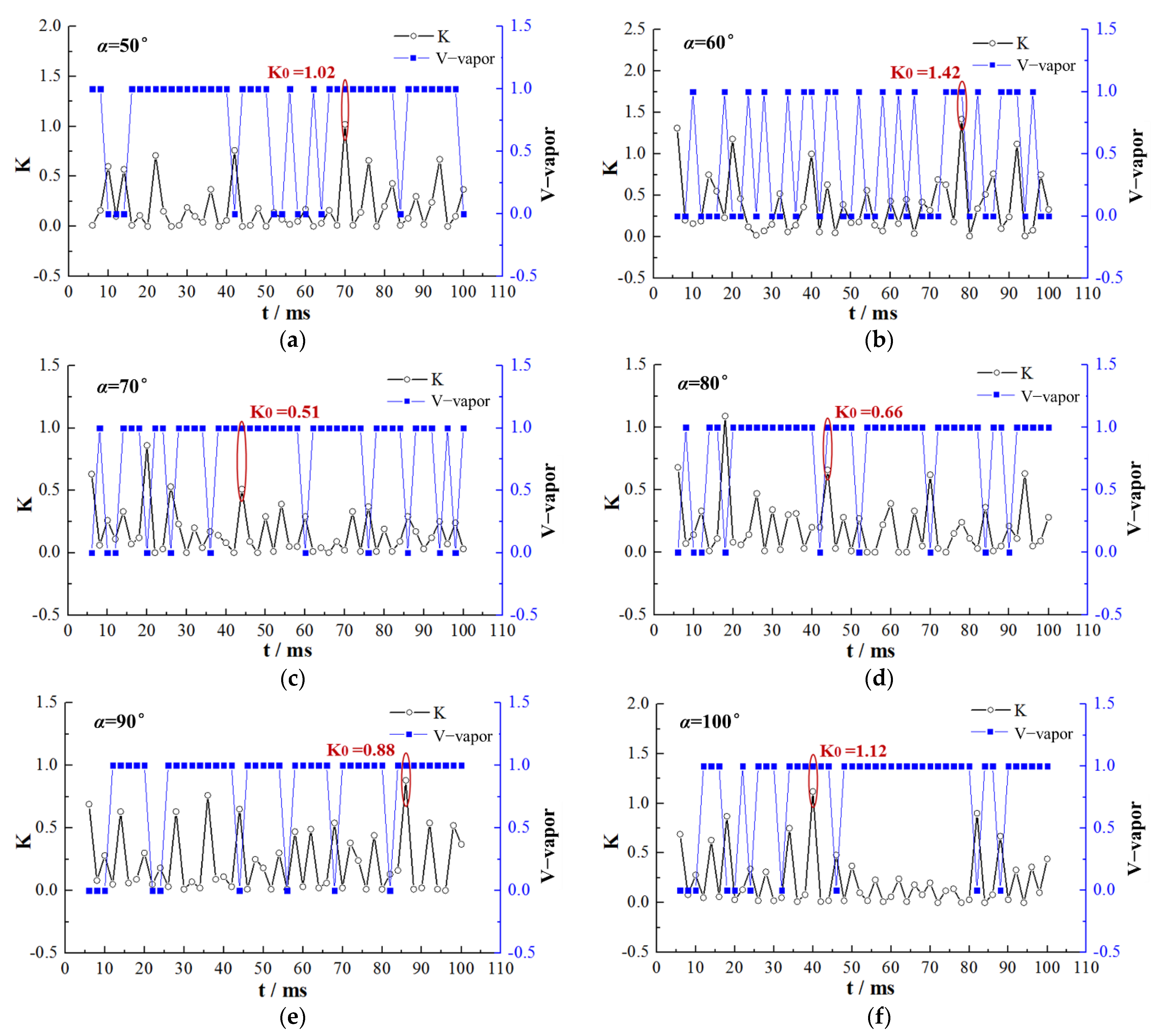

Publisher’s Note: MDPI stays neutral with regard to jurisdictional claims in published maps and institutional affiliations. |
© 2021 by the authors. Licensee MDPI, Basel, Switzerland. This article is an open access article distributed under the terms and conditions of the Creative Commons Attribution (CC BY) license (https://creativecommons.org/licenses/by/4.0/).
Share and Cite
Zhang, S.; Fu, B.; Sun, L. Investigation of the Jet Characteristics and Pulse Mechanism of Self-Excited Oscillating Pulsed Jet Nozzle. Processes 2021, 9, 1423. https://doi.org/10.3390/pr9081423
Zhang S, Fu B, Sun L. Investigation of the Jet Characteristics and Pulse Mechanism of Self-Excited Oscillating Pulsed Jet Nozzle. Processes. 2021; 9(8):1423. https://doi.org/10.3390/pr9081423
Chicago/Turabian StyleZhang, Si, Biwei Fu, and Lin Sun. 2021. "Investigation of the Jet Characteristics and Pulse Mechanism of Self-Excited Oscillating Pulsed Jet Nozzle" Processes 9, no. 8: 1423. https://doi.org/10.3390/pr9081423
APA StyleZhang, S., Fu, B., & Sun, L. (2021). Investigation of the Jet Characteristics and Pulse Mechanism of Self-Excited Oscillating Pulsed Jet Nozzle. Processes, 9(8), 1423. https://doi.org/10.3390/pr9081423





